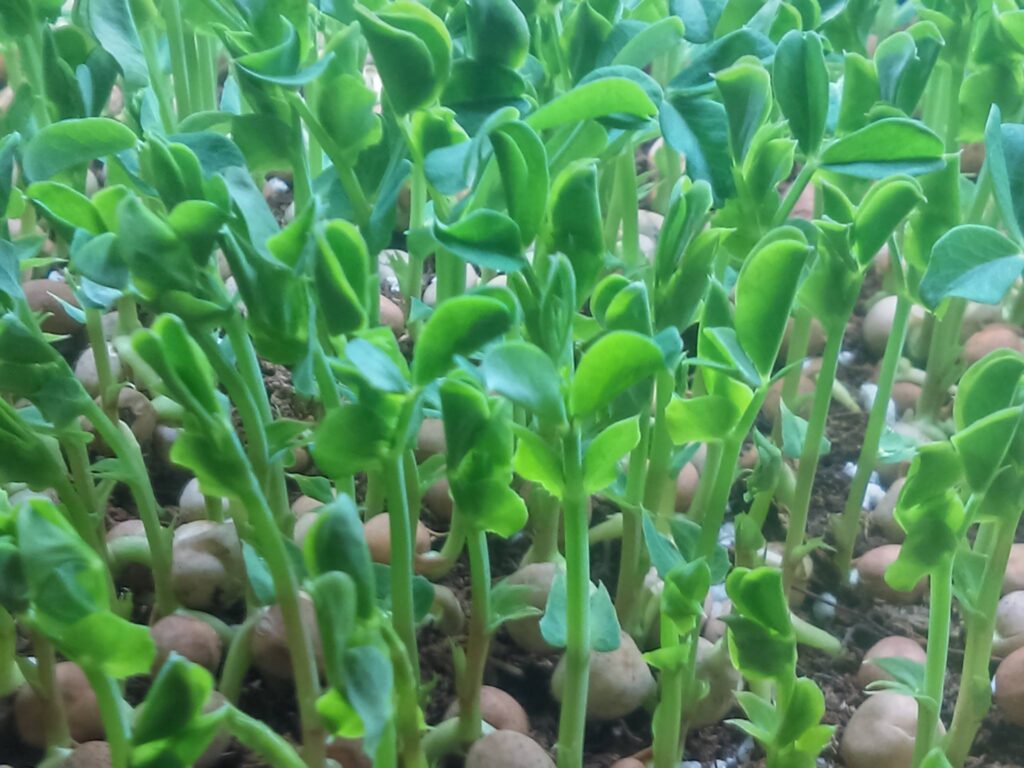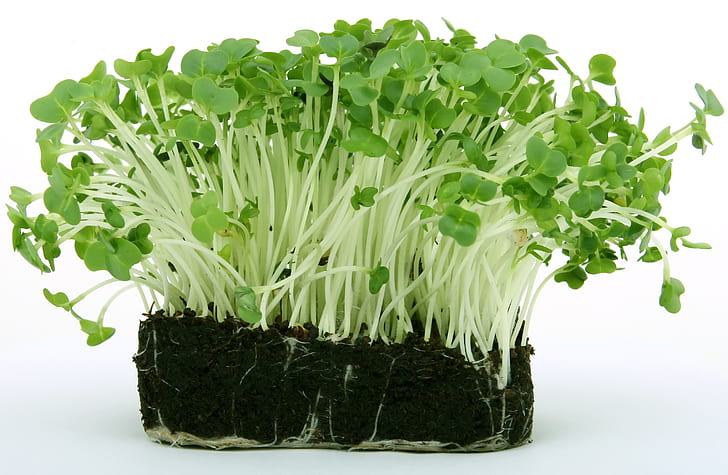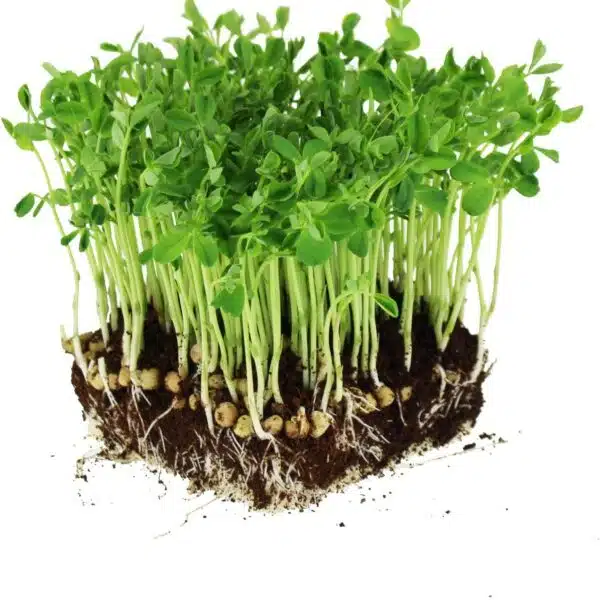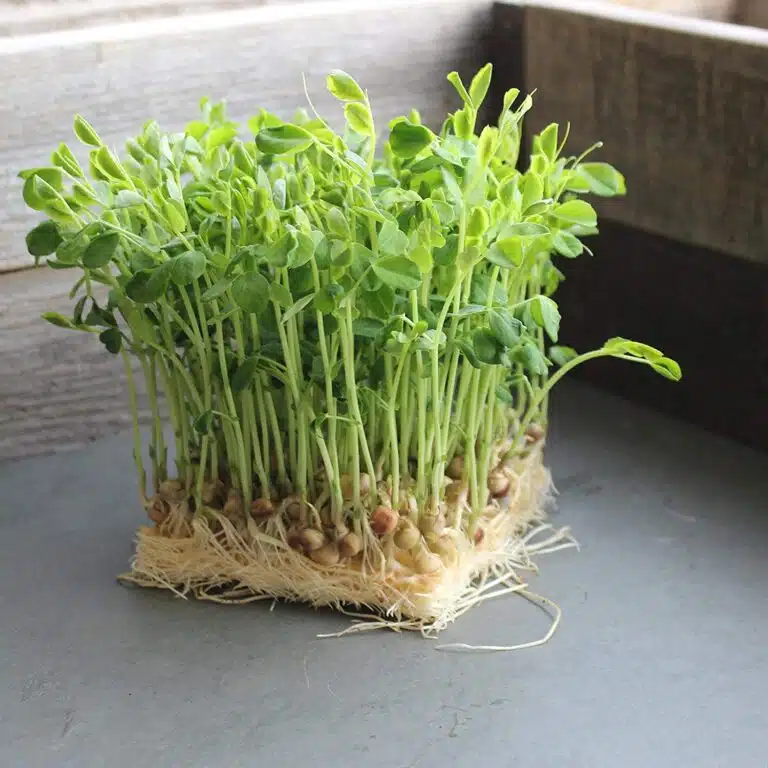Table of contents
ToggleAre you tired of buying expensive vegetables at the supermarket?
Are you thinking about starting and growing your own pea shoots? Then you've come to the right place!
In this article, we will guide you through the process of growing these flavourful vegetables on your own kitchen table or in your own garden.
Pea shoots are easy to grow and require minimal effort.
They are a healthy and delicious addition to your meal, and you can be sure that they are fresh and have not been stored for a long time in a supermarket.
What are pea shoots?

Pea shoots are small pea plants that are edible and can be used as an ingredient in various dishes known for their fresh flavour and crispy texture.
The little plants are one of the most nutritious vegetables around. They are rich in vitamins, minerals and antioxidants, which all contribute to a healthy diet. They are particularly known for their high content of vitamin C, B vitamins, potassium, iron and magnesium.
Their antioxidants make them an effective way to fight free radicals, which can damage cells in the body and lead to a number of diseases.
Their high levels of vitamin C and B vitamins also help boost the immune system and reduce tiredness and fatigue.
Pea shoots are grown from pea seeds and can be grown both in the ground and in sprouting trays indoors. They are easy to grow and require minimal space and can be grown all year round.
They are also beautiful to look at with their bright green colour and delicate tender leaves on crisp stems and small tendrils; a beautiful sight on any kitchen table.
How to prepare for successful pea sprout cultivation

Before you start growing pea shoots, you should prepare the following:
- Choose your seeds:
- Seed quality: Only buy seeds from reputable stores with good traceability and documented high germination capacity.
- Black: To achieve the best results. You should choose a variety of peas that suits your preferences. There are many different options to choose from, including green, yellow, red, sweet, and field peas among others.
- Certification: If you want to avoid chemicals, pesticides and fungicides that are harmful to your health, you should only buy certified organic seeds. Only choose suppliers that are certified by the Danish Agricultural Agency (see their Homepage), as it is your security for a high quality of the seeds delivered. Besides choosing organic seed, you should also consider buying seeds from local suppliers as it can be more sustainable and support local economies.
- Cultivation in environmentally friendly seed trays
- Sowing trays or sprout hills are a great method for growing pea shoots as they are user-friendly and require minimal space.
They are especially suitable for indoor cultivation as they can be placed in even small areas. In addition to being easy to clean, seed trays can also be reused year after year if they are of high quality.
- For easier cleaning and to protect the environment, it is recommended to choose seed trays that are dishwasher friendly.
It's important to make sure the tray has many drainage holes and comes with a good sub-tray, as pea sprouts thrive best with sub-irrigation to avoid rot and mould between plants.Choosing a quality sub-tray is essential for successful cultivation.
– Choice of grow lights
- Growth on the windowsill can lead to challenges with sprouts that stretch and easily topple over, slower growth and risk of desiccation. Cultivation under a good temperature is therefore recommended grow light lamp with a white full-spectrum light to achieve the best possible yield and the most beautiful plants. 140-200 μmol/s*m² light is the minimum requirement, SunLight Pro-Gro T8 lamps recommended by professionals micro green manufacturers.
– Which growing medium or soil is best?
- It is recommended to use coco coir/coconut flour as a growing medium for growing pea shoots, as it is cheap, environmentally friendly and drains well, and regulates humidity well.
- Rockwool also drains well, but is not environmentally friendly and difficult to handle indoors, as well as not recyclable.
- Soil (Garden/sowing soil / potting soil) is not suitable for growing microgreens, as it contains harmful bacteria and is not suitable for organic cultivation.
- Hemp mats are environmentally friendly, but are expensive, poor at holding water, and give a lower yield than coconut fiber.
- Bamboo fiber mat, suitable, but relatively expensive to purchase.
- Wood fiber mat, suitable, but relatively expensive to purchase.
Preparation of the pea seeds
To start the germination of the pea seeds, soak them in clean water for 8-12 hours. This helps the seeds absorb water and makes them round again, which promotes germination. Always use clean water as it can affect the germination of the seeds.
Use a 10mm thick layer of coconut fiber or other growing medium in a sprouting tray, which is lightly pressed together. Spread the watered seeds evenly in the tray and lightly press them down into the growing medium with another tray or body. To promote germination and rooting, it is recommended to place another tray on top of the seeds so that moisture is maintained and the seeds think they are in the ground, which is why they set the roots faster than with just a lid/plastic film on the tray.
Watering and caring for the pea plants
After planting the pea seeds, they will begin to establish roots in the coir fibers and then continue down into the subsoil. It is important to keep an eye on the water level, as the peas require sufficient moisture to grow and thrive. Be sure to water regularly, both in the morning and in the evening, and watch the growth of the plants to assess how much they need to be watered. Remember that too much or too little water can damage the roots and lead to the death of the pea shoots.
The temperature in the room where the peas grow must be kept between 18-25°C to promote the best germination. After approx. 10-14 days the small pea shoots will be ready to be harvested. Be sure to cut or cut them carefully so you don't damage the roots or the growing medium. Enjoy the delicious and nutritious peas, either raw or cooked, as part of a healthy and varied diet.
Harvest and storage
After 10-14 days, the pea shoots will be ready for harvest, and they will typically be between 10-15 cm in height. It is recommended to cut them 2-3 cm above the seed with sharp scissors or a knife to avoid damage to the next generation. After harvest, continue to water to get another round of shoots after 1 week. It can be repeated 2-3 times, but with decreasing yield for each round. To increase the yield, you can add a good liquid fertilizer to the water.
The pea shoots can be stored in a closed container in the refrigerator for a few days and if used coconut fiber and organic seeds, it is not necessary to rinse them before use.
Difference between pea shoots and pea sprouts
| Aspect | Tendril (Pea Sprouts) | Chickpeas (Microgreens) | Pea shoots |
|---|---|---|---|
| Taste | Mild, sweetish | Slightly nutty | Fresh, slightly sweet |
| Growing time | 10-14 days | 8-12 days | 12-14 days |
| Nutrients | High in vitamin C and protein | Rich in protein and fibre | High in vitamin A and C, iron, calcium |
| Typical Applications | Salads, sandwiches, garnishes | Snacks, salads, cold cuts | Salads, stir-fries, as garnish |
Pea shoots – A versatile and healthy ingredient
Pea shoots are a tasty and versatile ingredient that can be used in many different dishes. They can be added to salads for extra flavor and crunch, or as part of a vegetable mix in a wok dish.
Pea shoots are also a good addition to sandwiches or pizza toppings, and can be added to pasta dishes or served as a healthy side dish. They can also be dried and used as a snack or as an ingredient in a vegetable mix that can be used in various dishes. They can even be used as a decoration on various dishes.
Experiment with pea shoots in cooking
- There are many ways to use pea shoots in cooking. You can experiment with making your own pea shoot dressing or pesto by blending pea shoots with olive oil, garlic, lemon juice, salt and pepper. Or you can make a fresh pea shoot hummus by blending pea shoots with chickpeas, garlic, lemon juice, tahini, salt and pepper. The possibilities are endless, so experiment and find your favorite.
In salads
- An easy way to get more pea shoots into your diet is by adding them to salads. Here they add both flavor and crunch to salads, and make them more interesting and varied. You can add the pea plant to a green salad, a pasta salad or a quinoa salad. You can also add the green shoots to a cold cabbage salad for extra flavor and crunch.
As a sandwich or pizza topping
- Pea shoots can also be used as part of a sandwich or pizza topping. They will bring a crunchy and fresh element to your sandwich or pizza, and can be combined with a variety of fillings, such as cheese, ham, beef or vegetables. Their mild taste will not overpower the taste of the other ingredients, but will instead contribute a crisp texture and a fresh taste.
Wok dishes
- Pea shoots are also a good option to bring a crunchy element to a wok dish. You can combine them with a variety of vegetables, such as broccoli, carrots, beets and onions, to create a colorful and tasty wok dish. Their mild taste will not overpower the taste of the other vegetables, but will instead contribute a crisp texture and a fresh taste.
Pasta dishes
Pea shoots are a type of vegetable often used in pasta dishes. They have a sweet and nutty flavor that pairs well with pasta, and they add both color and texture to dishes. The plant shoots can be boiled or steamed before being added to the pasta, and they can be combined with a variety of sauces, such as tomato sauce, pesto or cheese sauce.
FAQ
Pea shoots are tender shoots from pea plants. They are rich in vitamins and minerals. Known for their fresh, slightly sweet flavour and crispy texture.
They can easily be grown indoors from pea seeds and are popular in salads, sandwiches, and as a garnish in various dishes.
Pea shoots are good both nutritionally and environmentally.
To grow pea shoots.
Sow pea seeds in the ground or in germination trays and keep them moist in good light.
After germination, pea shoots are ready to harvest within a few weeks. They should be 10-15 cm high.
Pea shoots are healthy.
The plant is rich in vitamins (C, A, and K), minerals, plant protein, and offers digestive fibre.
They also strengthen the immune system and contribute to overall health with low calorie content.
Pea sprouts are young, tender shoots of pea plants. They are eaten for their nutritious content and fresh, slightly sweet flavour. They are a source of vitamins, minerals and plant protein. They are often used in salads and as a fresh garnish.
To grow pea sprouts.
Soak pea seeds in water overnight and place them in a sprouting tray. Keep them moist at room temperature. The sprouts are ready to harvest after about a week when they have developed small green leaves.






